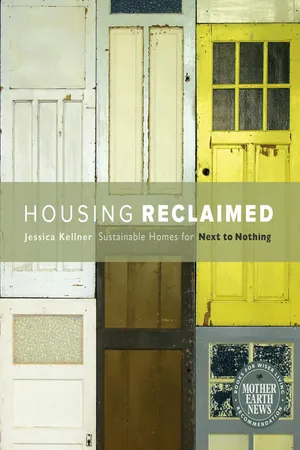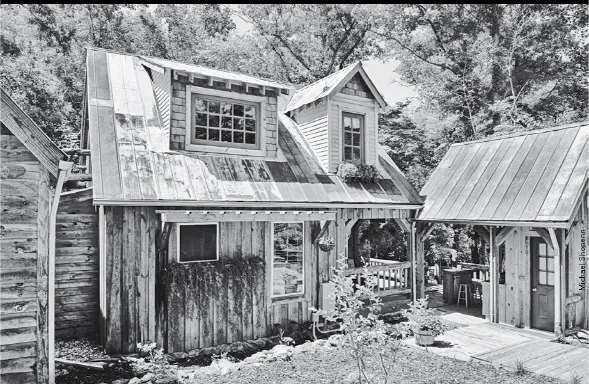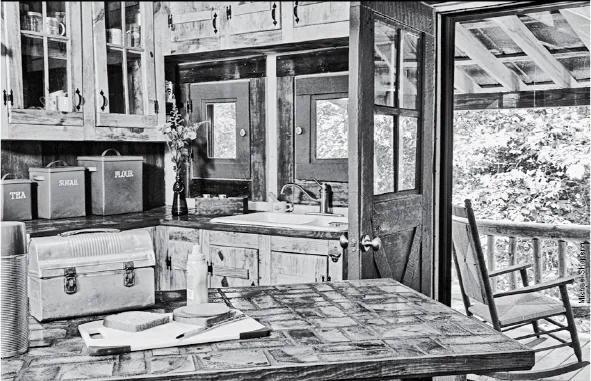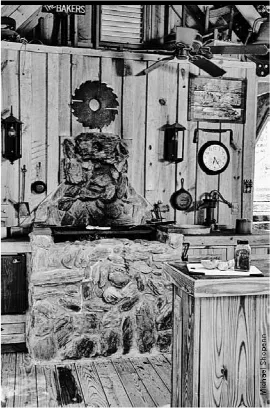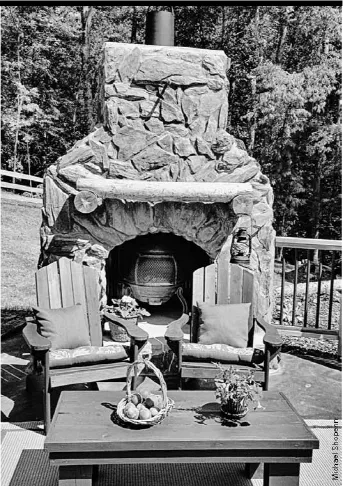![]() PART 1
PART 1
HANDBUILT HOMES![]()
CHAPTER 1
ALL IN THE FAMILY
An Alabama family comes together
to hand-build a home and connect with
each other and their region’s history
in the process.
IN WEDOWEE, ALABAMA, Guy and Kay Baker live in a cozy cottage they built with their three sons using almost entirely salvaged materials collected from all over their county. Under the guidance of Guy, a lifelong professional builder, the family spent about five years on the project, lovingly and painstakingly building the intimate space using centuries-old materials. The family so loves their handbuilt home, initially planned as a vacation cottage, that they ended up moving in full-time, and every day Kay and Guy enjoy the personal connection they have with every detail of the 1,100-square-foot space.
In 2001, Guy was overwhelmed at work, and Kay was working on her bachelor’s degree in psychology. The couple’s three young sons were getting increasingly busy with school and personal lives. When Guy’s mother unexpectedly fell ill and passed away, Guy became acutely aware of the sensation that life was passing him by. He felt driven to make good on a longtime dream of building a getaway in the woods for himself and his family.
Kay and Guy had owned the land on which they planned to build — formerly owned by Guy’s grandfather — for years, but they’d never gotten around to starting the project. Eager to reconnect with his past and the things he values most in life, Guy was inspired to get moving on the project after his mother’s death: “It was something I had always wanted to do, but I’d always put it off. Things just got in the way — work, school, the boys. We were just making excuses for never doing it. But my mother had gotten sick in 2001 and passed away, and I think that was the reason I went ahead and quit making excuses and just found the time to do it.”
For Guy, his family was building more than a home; they were building a place for calm and family togetherness, a place to escape the hectic world. “The biggest reason for doing it was that my workload had gotten astronomical. I had no down time, and with the boys at the age they were, we just needed some peace and serenity,” he says.
The Bakers’ 1,100- square-foot cabin is made with 85 percent reclaimed materials the family collected from all over Randolph County, Alabama.
Guy had long had a fascination with the array of antique building materials he saw while working on tear-down buildings in the area. He was impressed with the materials’ good quality and durability, even after they had withstood the elements for hundreds of years. He saw the antiques he’d collected as heirlooms of a bygone era that valued craftsmanship over speed. “I was always and still am fascinated with older structures and older materials. It amazed me that I could work on houses that were 150 years old, and the damages to these homes were minute because of the materials and the quality of the studs and the lumber,” he says. “A year later, you work on a home that’s only 20 years old, and you saw all this termite and water damage.”
For years, Guy had been collecting items — bits of the region’s architectural history — gathered from projects in the area. Though he hadn’t been sure at the time what he would do with them, he knew those great old things were too wonderful to throw away. When it came time to start construction on his family cabin, Guy realized he had probably collected nearly enough reclaimed materials to build the whole cabin. He knew the unique materials would give his home a one-of-a-kind feel. “You couldn’t purchase the boards in this home nowadays,” Guy says. “Even if you tried to duplicate it, you couldn’t. They’re all one-of-a-kind. Most of the boards were hand-hewn with a chop-axe, and they were in excellent condition. That was fascinating to me: to be able to take something that had been out in the elements for hundreds of years and it was still good quality.
Guy and Kay estimate they spent $20 on the kitchen; hinges and doorknobs were the only things they paid for. Kay laid the wood-block countertops herself.
” Having spent 20 years building in Randolph County, Guy had more than his collection of antiques to call upon when he started building his own home. He also had a vast knowledge of all the area’s best sources of reclaimed and antique building materials. “All these materials were readily available. They were everywhere,” he says. People in the area who were tearing down old structures often didn’t have another destination for them, so Guy took them off their hands. “Being in the construction industry, I saw it everywhere — say we were tearing down an old barn with great old wood. If you ask them if you can have it, nine out of ten people say, ‘Sure!’”
Guy’s collection of building supplies and his knowledge of how many additional resources were available in the area helped convince Guy and Kay to build the home in the first place. The free materials made building their home a low-cost endeavor. “After being in this business for years, I knew I could build what I wanted at a very minimal cost, and we did,” Guy says. He and Kay were determined to avoid taking on debt to build their dream home. Over time, finding free supplies became a game to Guy. “It came to the point that you didn’t want to spend anything,” he says. “Anytime you needed something, you knew it was out there, and you could find it. It almost became a challenge to not spend any money and be able to do this.”
An old Indian grindstone the family found on the property serves as decor in the outdoor kitchen supply building.
Guy searched far and wide to find the best materials to use in his home, then used creativity, artistry and hard work to incorporate them into his home.
He used entirely antique window panes from an 1800s church his company worked to deconstruct. People said the church was the oldest in the county, and Guy spent hundreds of hours reframing the antique panes with reclaimed wood. He estimates creating new window frames from reclaimed wood and fitting the panes took him about 60 hours per window — and there are 12 windows in the house. He created a gigantic bathtub by lining a cattle trough with fiberglass. Guy estimates he spent $20 on the kitchen — doorknobs and hinges were the only thing he paid for. The outdoor stone fireplace is made of stones collected on the property. Old road signs and American Indian grindstones found on the property act as decor.
Though safety required that some building materials such as plumbing and wiring be new, overall the project cost virtually nothing. “Other than the wiring and the plumbing and things like that, we didn’t spend any money,” Guy says. He was able to hunt down just about everything they needed from the many old buildings in their rural area. And though saving money was part of the motivation, the family was also keen on using reclaimed materials because they liked incorporating their region’s history into their dream home. “In this part of the country, farming was the main industry, so barns are everywhere. They’re dilapidated, but there’s a lot of good lumber in those things,” Guy says. “It was partially monetary and part just being fascinated with the idea that you could take something someone built 100 years ago, take it apart and create your own dream.”
Building the home together brought the Baker family closer and instilled a huge sense of confidence and can-do spirit in the Baker sons. Left to right: Jeffery, Adam, Kay, Guy and Kyle.
The Ultimate Family Project As Guy collected materials (he says he used something from every town in Randolph County), the Baker family started spending their evenings and weekends building. From roofing and tiling to laying flooring, the family members took on every task. The boys, Jeffery, Kyle and Adam, who were 15, 14 and 12 when the project started, were assigned specific jobs, such as constructing the outdoor fireplace from rocks found all over the property.
Youngest son Adam says he touched every one of the thousands of rocks used in the outdoor fireplace, foundation and dry creek beds three times — once when he found a stone, once when he moved it to the house and once when he laid it in its final destination. Kay tiled the kitchen floor and countertops with “tiles” made of barn wood Guy cut into small slices. She then coated each one with polyurethane for a shiny effect. “The wood was from barns and floors,” Kay says. “Guy took it and sliced it like a loaf of bread. They were different sizes. Then he told me how to pattern them and lay them out as tiles. We did that on the countertop and the floor. It’s a little crooked, but it’s still beautiful,” she says.
Guy and Kay viewed building their home as an important way to teach their sons the value of hard work and to show them what a huge feat they could accomplish working together as a family. Working hands-on together provided the family a way to connect outside the normal day-to-day grind, and it taught Kay and Guy’s sons the importance of dedication.
Though the teens may have grumbled at times as they made their way through the project, today all three Baker sons realize the invaluable lessons they learned from building the home, and they know their home is worth all the hard work. Jeffery and Kyle also gained a foundation for their careers through the project — both are professional builders working for Guy today. Middle son Kyle says that, though the project was challenging, he gained enthusiasm as the home came together: “At first, I hated it. That’s the last thing you want to do with all your free time when you’re 16 and 17 years old. But later on, all the pieces of the puzzle came together. When it got closer to the finished product, you saw how neat it was and you wanted to do more to it.” He remembers how the project empowered him, and it’s still a source of pride: “I remember rocking the inside of the fireplace. I pretty much did that by myself. I’d never done anything by myself. I’d probably never been trusted to, but I did that. I’m proud of it.” Kyle says the project helped him determine that he wanted to be a professional builder, but also that he could do anything he set his mind to: “It showed me that I was able and capable of doing some of this stuff, and now I’m getting paid for it. It opens your mind to all the things you can actually do if you just get down and try it.”
Adam says working with his parents helped him develop a stronger, more mature relationship with them:
“There is a certain amount of time you have to spend with a person before you truly know them. Until you’ve seen your parents react to frustration in a very human way, you can’t say for sure what type of person they are.” Watching as their parents demonstrated grace under pressure showed the Baker sons the best way to react to difficult challenges, Adam says: “I had the opportunity to see how both of my parents deal with stress, and it built respect between us. They did not have to tell me to be moral or honest; they showed me by example. They did not throw a fit every time a rock refused to stay cemented to the wall. We saw what was happening and learned from it.”
Collecting stones from all over the property and laying the outdoor fireplace with them were some of the Baker sons’ tasks.
Along with the value of accomplishing goals, Adam admits the project also taught him the value of failure, and of perseverance: “If I succeed without making any mistakes, I fail to learn something new. What is an accomplishment if we’ve learned nothing from it?” And, though he learned a lot about his parents and brothers, working through the challenging project also helped Adam learn about himself: “Everyone has character flaws. My family loves me enough to point mine out. They’ve helped me become a better person by showing me things about myself I couldn’t see on my own.” Adam says he grew up while building the project from ages 12 to 17 and that it helped him navigate the sometimes difficult road to adulthood: “Every one of us changed while building that place, but we grew together, not apart. It was therapy to get our minds back on track after the pitfalls of everyday life. Building that house helped me cope with the death of my grandmother and two close friends. I became a man. I grew closer to my father. I got to know my brothers. I learned to appreciate my mother. She is my link to the past and what keeps me moving forward.” Adam also built the foundation of what he hopes is his future career — he’s applied to architecture school at the University of North Carolina in Charlotte.
Kay agrees that everyone in her family grew through their work on the project. Building the home helped her sons become the responsible, capable adults they are today, she feels: “This project just instilled something inside of them. All three of the boys have such a huge sense of independence, and it seems to have come from this project — working like they did, realizing they could make anything happen. It made us really close.” Guy sees the home as a testament to his family’s dedication: “I love that when my sons come in this house, it’s a reminder of what hard work and dedication can do. At the time, they weren’t crazy about doing it like I was. But now the boys can remember doing each task, and it becomes really personal. It’s more than a house, when you know that yo...
